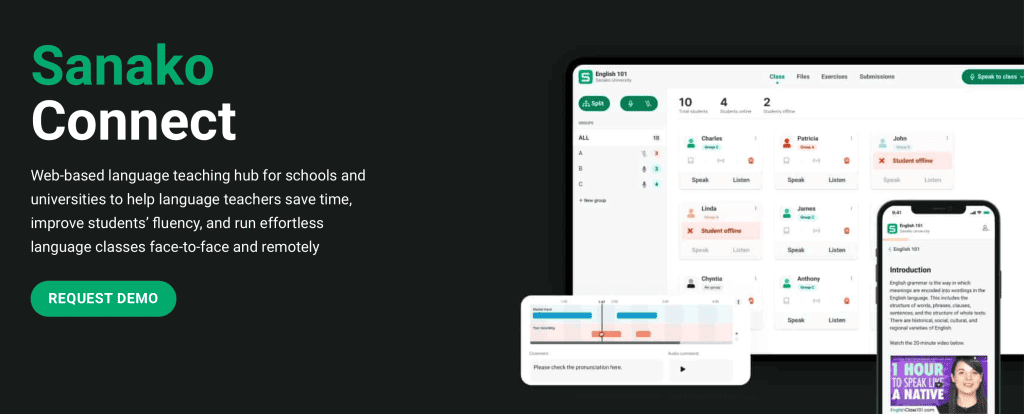Every language educator knows that vocabulary acquisition is a key aspect of language learning. But they also understand that some words are more important for students to learn than others regardless of the target language. Helping learners to understand and focus on those most essential words is a key strategy that speeds up the language acquisition process.
This blog post therefore focuses on the concept of core vocabulary lists. It aims to help language educators (and learners) to easily identify and use the high frequency, high-value words that will be most helpful to develop their fluency and skills.
What are core vocabulary lists?
Research in the field of vocabulary acquisition (and using common sense) shows that certain words are, in any language, more commonly acquired before others. The words that we use to express simple ideas in easy, everyday sentences are invariably acquired early. According to OUP’s work on the subject, this includes “basic function words (articles, prepositions, basic conjunctions), common verbs (have, get, go, do,make), nouns (thing, people, day), and adjectives (new, good, first).”
Perhaps unsurprisingly, detailed research has shown that the 3,000 most frequently used words in English, for example, actually make up almost 90% of everyday text. Focusing on these high-frequency words can therefore give students a pretty comprehensive overview of the words that they are most likely to encounter. Encouraging students to spend time learning these words should provide a notable uplift to their comprehension and communication skills.
This is reinforced by Milton and Alexiou’s 2009 research which looked at learners’ approximate vocabulary size at different levels of the Common European Framework of Reference (CEFR).
|
Vocabulary size in English |
Vocabulary size in French |
|
|
A1 |
<1,500 |
1,160 |
|
A2 |
1,500–2,500 |
1,650 |
|
B1 |
2,500–3,250 |
2,422 |
|
B2 |
3,250–3,750 |
2,630 |
|
C1 |
3,750–4,500 |
3,212 |
|
C2 |
4,500–5,000 |
3,525 |
Their work clearly illustrates that a considerable amount of work is needed to learn enough words to get to A1 and then A2. But beyond that, the rate of new words seems fairly consistent, with around 500 new words being needed to climb to the next CEFR level.
Where can I find these vocabulary lists?
The most widely known of these lists (for English, at least) are the Oxford 3000 and the Oxford 5000. They were launched in 2005 and were designed for use with secondary and adult learners of general British English.
Importantly, the Oxford 3000 is focused on supporting learners from A1 to B2 level, whereas the Oxford 5000 extends the list to C1 level. Given the clear alignment with the CEFR levels, users can easily see the words they need to learn in order to progress to the next one.
In formal education, the majority of national curriculum providers will supply a complete list of vocabulary for each qualification / language. Students will obviously need to be able to recognise and understand all of these words to succeed in their examinations.
Rather than using pre-populated resources, educators and institutions could create their own lists to better reflect their pedagogical approach and student intake. We recognise that this isn’t an easy task, so perhaps using a list from a trusted online source might be a good place to start!
Using core word lists in the classroom
Wherever the word list comes from, such tools can be hugely helpful in supporting teachers to plan vocabulary learning activities and track progress. They certainly ensure that effective teaching and learning is taking place.
As well as forming the basis of a wider vocabulary syllabus, word lists can be used to create specific classroom materials. Teachers can use the lists to check the level of all words included in a piece of text – equally the list can help analyse all of the text to assess its suitability for classroom use.
The following 5 ideas work well whether you choose to use one of the lists above or one that you’ve produced yourself. In both cases, improving students’ vocabulary acquisition is the ultimate goal.
- Context is king: Immersion in real-life contexts is a vital facet of language learning, so provide your learners with sentences, dialogues and texts into which their target words are seamlessly woven. By showcasing these words in everyday situations, students can grasp their definitions and the nuances of their usage. Try to engage learners in lively discussions, role-playing exercises and storytelling projects to build their contextual understanding.
- Connecting the dots: Categorising words into thematic clusters can also serve as a powerful scaffold for memory retention. Leverage this by creating lessons focused on thematic categories to establish a cohesive and relatable learning experience. You could focus on the environment, food or travel, but whatever topics you choose, students will find it easier to remember vocabulary when they can see how words are connected.
- Spaced Learning: The power of repetition is vital to vocabulary learning success – techniques such as spaced repetition have been proven to strengthen memory. Equipping your students with tools like digital flashcards and language apps is a good start – these use advanced algorithms to optimise learning reinforcement. You could also implement regular review sessions, quizzes and games to revisit previously learned words.
- Personalisation: Encourage students to feel ownership of their learning by using the target vocabulary wherever possible. Whether through vocabulary notebooks, journal entries, short stories or conversations with peers, this process instils practical application and a deeper connection to the words.
- Track progress: When learning a set list of vocabulary, it’s important to set attainable milestones and encourage students to track their progress carefully. Regular assessments, constructive feedback, and the celebration of accomplishments serve as potent motivators to keep them engaged and enthusiastic.
In addition to using word lists in the classroom, they can also support learners to acquire and consolidate word knowledge during self-study sessions. This can be particularly valuable as there is often insufficient time to go through every word on the lists and ensures that they have all been fully understood and committed to memory.
Lists such as the Oxford 3000 also provide reassurance that students are learning useful vocabulary. And because they break words down into manageable chunks at each level, students get a clear picture of the progress they are making. All of these factors help motivate students to develop their vocabulary both inside and outside the classroom.
If you’d like more tips and tricks to build your students’ vocabulary, then check out another Sanako blog post “Tips and tricks to build your students’ vocabulary more effectively“.
How Sanako can help language educators build their students’ key vocabulary
Sanako’s language teaching tools can help educators to improve their students’ range of vocabulary. Our Sanako Connect language teaching hub enable educators to:
- Create activities that test students’ vocabulary using a wide variety of media including sound files, text, presentations, videos and/or web pages, and digital flashcards.
- With Sanako Connect’s digital flashcards you can give your students virtually unlimited opportunities to practise key concepts and vocabulary. Your students can work on your flashcards whenever and wherever they want.
- Build tailored vocabulary assessments for individual students or groups. Connect can easily help educators to construct and mark multiple choice quizzes, free text entry and gap fill quizzes to identify what they know and where more work is needed.
- Facilitate simultaneous conversation practice. Students have ample opportunity to use their new vocabulary with partners and / or groups. Teachers can also listen in, give feedback in real-time and even record each group discussion for later review.
If you’d like to find out more about how Sanako’s dedicated language teaching solutions could transform your approach to growing your students’ vocabulary, please contact us now to arrange your FREE demo.

